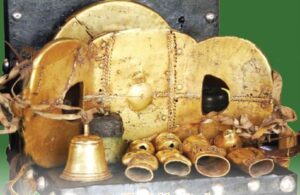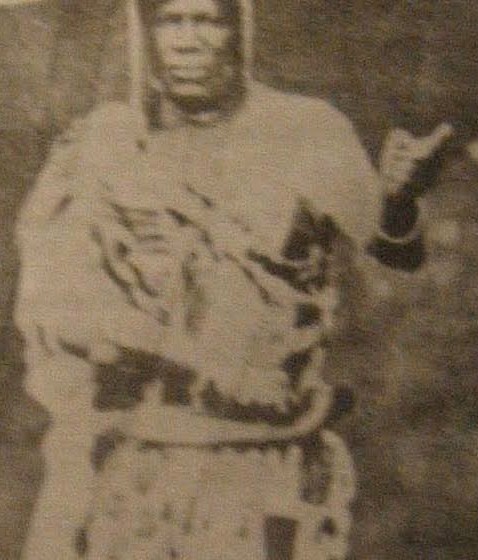
“WHY THERE ARE AMANHENE, AND THEN THERE IS….. ƆTEKƆKƆƆSOƆ”
Rather than engaging in puerile historical masturbation that some seem to have fallen into.
Just for clarification, and to get some to ponder:
Akyem Abuakwa; Akyem Bosome; Akyem Kotoku; Dɔmaa Ahenkro; Takyiman; Kwawu; Akwamu; Dankyira; Dwaben; Mampɔn; Adansi; Bekwai; Offinso; Kokofu; etc., etc., are all like Class Mates. They are all Amanhene.
Some, like Dwaben and Mampɔn may come with huge entourage and even more gold paraphernalia, but I would argue they are on a similar (though not same) platform as Amanhene or what the British termed Paramount Chiefs, which “term” is however not to be equated with Ɔmanhene status in a historical sense.
These Paramount Chiefs are “paramount” only in a given area. They will NOT create, nor agree to create other Paramount Chiefs (or “Amanhene”) in areas within their jurisdiction. This is the Custom and Tradition in Akandom.
Nananom Akyem Abuakwahene, Dwabenhene, Dɔmaahene, Akuoapemhene, Akwamuhene, etc., etc, will never create another Paramount Chief. That will be a challenge to their own tenancy. It would be a sham. It will be a joke. It will be a quicksand.
OTUMFUO ASANTEHENE however, creates Amanhene in his jurisdiction. He creates Paramount Chiefs. That’s because Otumfuɔ Asantehene is NOT Omanhene. ASANTEHENE is NOT a Paramount Chief.
That is the authority given to the occupant of SIKADWA at the founding of the Asante Nation in 1701. This happened, after successfully liberating themselves from Dankyira, and then subjugating Dankyira. And, subsequently all others to vassalage. That is a historical indisputable fact.

The Asante expansion and control, was partly curtailed by a foreign interloper in 1831 when Britain set the boundary at the River Pra. And again, in 1888 when Britain and France divided the Gyaaman portion of Asante as their resoective colony. Then finally, in 1896, Britain (1902) ended Asante independence.
The authority provided to the Asantehene to create Amanhene, is affirmed by the unwritten Asante Constitution.
Pursuant to the Asante Constitution, Otumfuo, is nominated, first as Kumasemanhene. This is done by Nana Asantehemaa, in her dual role as Asantehemaa, and also as Kumasemanhemaa. She does so by nominating a candidate, who is then presented to the Kumase Abrempɔn by the Gyaase.
The Kumase Abrempɔn, the occupants of the major Kumaseman Stools such as KONTI, Akwamu Gyase, Adonten, and Ankɔbia, are led by Baafuɔ Bantamahene who is the head of the KONTI Fekuo (Division). Baafuɔ Bantamahene acts as Kumasemanhene in the absence of Kumasemanhene.
However, it is Nana Mampɔnhene who acts as Asantehene, pursuant to the Asante Constitution. Baafuɔ Bantamahene is not Omanhene, though like some Kumase Abrempɔn he is accorded protocol Omanhene status at the Asanteman Council sitting.
Once the nomination is accepted by Kumaseman, and other rites completed, he invokes Ntamkɛseɛ (Oath), and Swears Allegiance on Mponponsuo Sword to Santehemaa, Kumase Abrempɔn and Kumaseman.
Nananom Kumase Abrempɔnfuɔ such as Baafuɔ Bantamahene, Adɔntenhene, Akyempemhene, Asuonwunhene, Gyassehene, Akwamuhene(Asafo), Ankobiahene, etc., then swear allegiance to the Kumasemanhene.
With the Kumase Rites having been completed, the Omanhene of Kumase, becomes de facto OTUMFUO ASANTEHENE.
This is uncontested position, by virtue of provision in the Asante Constitution which makes the Kumasemanhene, the occupant of Sikadwa automatically ASANTEHENE. But, he also has to swear to the Asante Amanhene in order to complete the process.
There’s a historical affirmation to that constitutional provision.
Before the SIKADWA descended gently onto the lap of Osei Tutu Kofi in 1701, by prior consensual agreement cemented by a binding Oath (Nom Asamansa) among the constituent Amanhene; they affirmed Ɔsɛi Tutu and his Ɔyoko Abusua lineage in Ɔsɛikrom as Santehene in perpetuity. No challenge. It’s been done SIXTEEN TIMES over 300 years.
To complete the rites, and to complete the Asante constitutional requirements, the Kumasemanhene then swears to Nananom Asante Amanhene. When Otumfuo Santehene swears to Sikadwa; it means he swears to the Amanhene This portion of Rites is not done in public. The Sikadwa is the constituency of the Amanhene (including Kumasemanhene).
All their STOOLS prior to 1701 (with the exception of Oyoko Ancestress Nana Akyewa Name Stool); and important articles of regalia and power were ritually incinerated, and the ashes infused into Sikadwa, spiritually by Prophet Okomfo Anokye. Hence, Sikadwa is described as the ƆKRA, the SOUL of Asanteman; Asanteman KRA.
With that done in private, the Amanhene in turn, swear allegiance to him in public, on behalf of their AMAN and people, all using Mponponsuo, and invoking OTUMFUO NTAMKƐSEƐ.
Additional ancient rituals are then completed with the Busumuru Sword at Pampaso, Kumase, to spiritually fortify and strengthen the new Santehene.
He is then said to have mounted ABAANWA meaning BARIMA ADWA. He becomes ƆTEKƆKƆƆSO, that is, he sits on SIKADWA…. GOLD STOOL, effervescent, powerful, unconquerable.
ALL the accolades of the various Amanhene, Abrempɔn, and Chiefs of Asanteman, such as: Ɔdɛɛfuo, Daasebre, Ɔdeneho, Ɔsagyefuɔ, Ɔseadeɛyɔ; Okoda, Okotwasuo, Okatakyie; Ogyeabuo; Odiatuo; Baafuɔ, etc., etc., are then woven together as one accolade for Asantehene; Otumfuo Santehene. Please do not add “His Majesty” or “His Royal Highness”, to Otumfuo. It is trifling in context and in comparison. He is OTUMFUO. Being Osei Tutu, he is also OPEMSOƆ. the relentless one, untiring man of action. He dares to accomplish whatever he sets his sights on OPEMSOƆ.
ASANTEHENE therefore becomes OTUMFOƆ …. MPIMSO, ƆPEMSOƆ….. Almighty. In Majesty.
As ASANTEHENE, he creates Amanhene or Paramount Chiefs within his jurisdiction. He has created over 50 Amanhene. Nananom Yamfomanhene; Kukuoman; Tepamanhene; Asankareman; Bompatamanhene; Mimmanhene; Sampamanhene; Banamanhene (Banda); Gyapekromanhene, etc., etc
And, that’s because as ASANTEHENE, he is no longer Omanhene. He seamlessly transitions from Kumasemanhene to ASANTEHEMANHENE.. . ASANTEHENE. Nobody comes close in comparison. He has NO equal.
He can therefore create Omanhene without bringing his own position into challenge or disrepute. There is no tautology to that.
There are Amanhene. And, then there is ƆTEKƆƆKOSOƆ.
As the Asante traditional singers Nnwomkrɔfoɔ, chant:
Onyamekropɔn na ɔbɔɔ adeɛ, ɛna ɔbɔɔ Ahenenie, ɛna ɔbɔɔ Ahene beberee; ɛna ɔbɔɔ Santehene.
Mo Piiaawww
Source: Prof. Kofi Ellison (From my 2018 Posting) ON: WHY THERE ARE AMANHENE, AND THEN THERE IS….. ƆTEKƆKƆƆSOƆ





